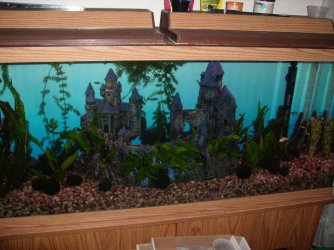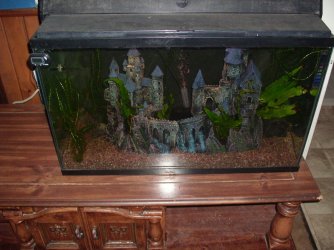This means a lot to me, thank you! I'm really happy to hear that you think I'm doing a good job with husbandry. There's always room for improvement, naturally, but it can be hard to take in so much information, along with differing opinions, and always question what you're doing! Fish keeping seems to be relatively newly studied, with new information about different species being published, opinions changing, and others disagreeing, loudly, lol. It's like if you look up information about keeping betta fish! Lots of persistent myths out there, newer information has been published, and people will argue about whether they can be kept with other fish or not all day long. Many here saying absolutely not, never! Others arguing that they've done it for years successfully. I've read about how bettas live in their natural habitat, but searched without success for film or documentary type info about how they live in the wild, if other fish of different species share the same water etc. Many scientific papers are behind a paywall. So then it comes down to a matter of common sense combined with personal opinion, and making your own mind up. I'd be upset if someone who knows better kept them in an unfiltered, unheated 2.5 gallon bowl, but not going to yell at someone if they have a healthy looking betta in a 10 gal with some raspboras. To me, not many people will have a flawless set up. A pretty good tank with some flaws doesn't mean they're a terrible fish keeper and the fish should go.
At the moment, my otos look really good to me. They're active, eat well, school together, and have chubby little round bellies anytime they're suckered to the glass. Seeing the difference between my original four I got in November compared to the new four I picked up in May/June really showed me the differences between a thriving oto and a struggling, stressed and hungry one. My LFS isn't a bad one, I promise, but clearly being wild caught, shipped, then put into shop tanks that don't have an established algae coat and relying entirely on algae wafers is rough on the poor guys. I didn't examine the oto tank closely when I bought them, I just asked how long he'd had them for, and asked him to bag four for me.
Drip acclimated them when I got home, then got a better look at them. One had the damaged tail, but don't know if that happened when netted or in shipping. Was concerned for bacterial or fungal infection since the top half was gone right up to the body, so kept the water very clean with plenty of water changes. I did lose that one after a week. They all looked so small and skinny compared to my original four. When they suckered to the glass, their bellies were absolutely flat, which worried me since mine were always rounded no matter if they'd just been fed or not. Overall body shape wasn't as filled out as mine, and their colours were more muted. I didn't quarantine these, because I was concerned they would't get enough algae and biofilm to eat without being in an established tank, since mine seem to do nothing but graze and take little rests all day, then play and school at night. I think shipping and being in a clean tank in a shop for a month, only being fed once or twice a day really had them so skinny and stressed

Within a few days though, they all had the round bellies, and now after the newer batch have been been there for two months, I can't tell the difference between them and the four that have been in there for nine months. I hope the hard water isn't doing long term damage to their kidneys, but at least for now, they're not stressed, starving or dying off, and aside from the harder water than ideal, it's a little oto heaven, lol. I deliberately cultivate some algae in the tank for them and the shrimp, have lots of plants with hiding places, and they love the Indian almond leaves when you snap them and curl them so it's like a little cave, and they eat whatever biofilm and micro creatures the leaves produce.
Also give them a variety of extra foods. I keep a log of everything that is going on in my tanks, like maintenance, births and losses, so will continue to monitor them and see how long they live for.
I'll keep working on how to do soft water though, since I'd love to try to breed Otos one day. If we as a hobby can figure out how to get them to breed more readily in captivity, we can stop them being wild caught. Sorry for the essay ranting, I just haven't been able to talk to anyone else who is interested in fish for a long time, have a lot of stuff to get out, lol.





 She did what she needed to do and secured her genetic future. I'm very grateful for your advice and your kindness with the otos and the shrimp, thank you.
She did what she needed to do and secured her genetic future. I'm very grateful for your advice and your kindness with the otos and the shrimp, thank you.